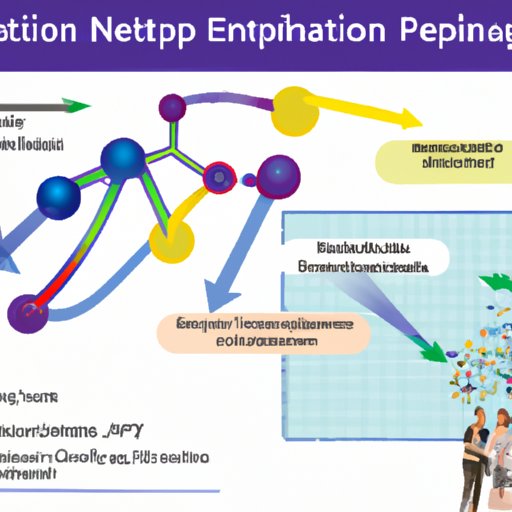Introduction
Neurotransmission is an essential process that facilitates communication between neurons in the brain. It is the means by which information is transferred from one neuron to another, allowing for the formation of neural networks and the transmission of signals throughout the nervous system. In this article, we will explore how information travels between neurons and examine the role of neurotransmitters, signaling pathways, structural components, and synaptic plasticity in facilitating neural communication.

Explaining the Process of Neurotransmission: How Information Travels Between Neurons
Neurotransmission is the process by which information is transmitted from one neuron to another via chemical signals. Neurotransmitters are released from the presynaptic neuron, diffuse across the synaptic cleft, and bind to receptors on the postsynaptic neuron, triggering a cascade of events that result in the transmission of information. There are several key steps involved in this process, which will be discussed in detail below.

Examining the Role of Neurotransmitters in Facilitating Neural Communication
Neurotransmitters are the primary messengers that facilitate communication between neurons. They are small molecules that are released from the presynaptic neuron and bind to receptors on the postsynaptic neuron. Depending on the type of neurotransmitter and receptor, they can either excite or inhibit the postsynaptic neuron, resulting in the transmission of information.
There are two main types of neurotransmitters: excitatory and inhibitory. Excitatory neurotransmitters tend to increase the likelihood that an action potential will occur, while inhibitory neurotransmitters tend to decrease the likelihood. Examples of excitatory neurotransmitters include glutamate and acetylcholine, while examples of inhibitory neurotransmitters include GABA and glycine. The release of these neurotransmitters is regulated by the presynaptic neuron, allowing for precise control over the transmission of information.
Investigating the Signaling Pathways Involved in Neuronal Communication
In order for information to be transferred from one neuron to another, several signaling pathways must be activated. The first step is the generation of an action potential, which is an electrical signal that travels down the axon of the neuron. This action potential triggers the release of neurotransmitter molecules into the synaptic cleft, where they bind to receptors on the postsynaptic neuron.
Once bound, the neurotransmitter molecules initiate a series of biochemical reactions known as synaptic transmission. These reactions involve the activation of various proteins, enzymes, and other molecules, which ultimately result in the transmission of the signal from the presynaptic neuron to the postsynaptic neuron. This process is essential for the formation of neural networks and the transmission of information throughout the nervous system.

Understanding the Structural Components of a Neuron and How They Affect Information Transfer
In order for information to be transmitted between neurons, several structural components of the neuron must be present. The axon is a long, thin projection that carries the electrical signal from the cell body to the terminal buttons. The dendrites are short projections that receive the incoming signals from other neurons. Finally, the cell body contains the nucleus, which houses the genetic material of the neuron.
These structural components are essential for the transmission of information, as they allow for the generation of action potentials and the release of neurotransmitter molecules. Furthermore, the shape and size of the axon and dendrites can affect the speed at which the signal is transmitted, as well as the strength of the signal.
Evaluating the Impact of Synaptic Plasticity on Neural Connectivity
Synaptic plasticity is the ability of synapses to change their strength and structure in response to changing environmental conditions. This process is essential for learning and memory, as it allows for the formation of new connections between neurons and the strengthening of existing connections. Furthermore, synaptic plasticity can also lead to the weakening of certain connections, allowing for the pruning of unnecessary neural pathways.
Synaptic plasticity can have both positive and negative effects on neural connectivity. On the one hand, it can lead to increased neural efficiency, as redundant connections can be eliminated and important connections can be strengthened. On the other hand, it can lead to decreased stability, as changes in the environment can cause drastic shifts in the strength of certain connections.
Conclusion
In conclusion, neurotransmission is an essential process that facilitates communication between neurons in the brain. Neurotransmitters are released from the presynaptic neuron and bind to receptors on the postsynaptic neuron, triggering a cascade of events that result in the transmission of information. These events involve the activation of various proteins, enzymes, and other molecules, which ultimately result in the transmission of the signal from the presynaptic neuron to the postsynaptic neuron. Furthermore, the structural components of the neuron, such as the axon and dendrites, play an important role in the transmission of information, as they allow for the generation of action potentials and the release of neurotransmitter molecules. Finally, synaptic plasticity can have both positive and negative effects on neural connectivity, as it allows for the formation of new connections and the strengthening of existing connections, but can also lead to decreased stability.
(Note: Is this article not meeting your expectations? Do you have knowledge or insights to share? Unlock new opportunities and expand your reach by joining our authors team. Click Registration to join us and share your expertise with our readers.)
